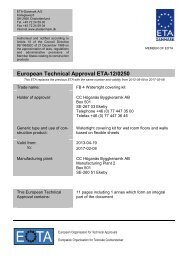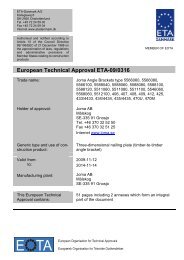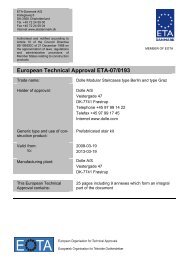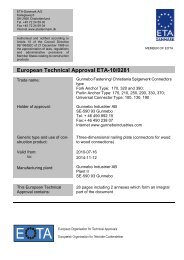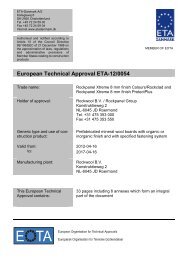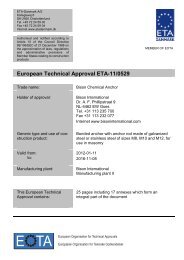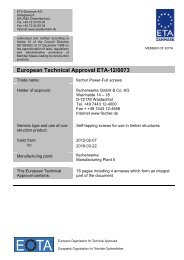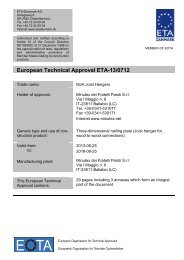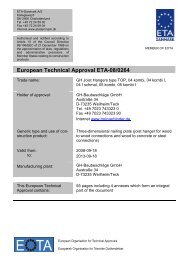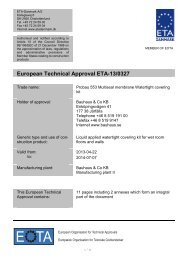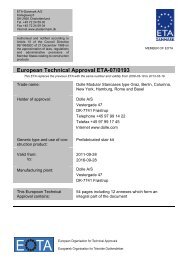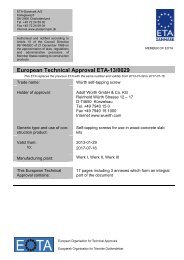ETA130190 IM PURE ETA 1 - ETA-Danmark
ETA130190 IM PURE ETA 1 - ETA-Danmark
ETA130190 IM PURE ETA 1 - ETA-Danmark
You also want an ePaper? Increase the reach of your titles
YUMPU automatically turns print PDFs into web optimized ePapers that Google loves.
<strong>ETA</strong>-<strong>Danmark</strong> A/S<br />
Kollegievej 6<br />
DK-2920 Charlottenlund<br />
Tel. +45 72 24 59 00<br />
Fax +45 72 24 59 04<br />
Internet www.etadanmark.dk<br />
Authorised and notified according to<br />
Article 10 of the Council Directive<br />
89/106/EEC of 21 December 1988 on<br />
the approximation of laws, regulations<br />
and administrative provisions of<br />
Member States relating to construction<br />
products<br />
European Technical Approval <strong>ETA</strong>-13/0190<br />
Trade name:<br />
Holder of approval:<br />
Generic type and use of construction<br />
product:<br />
Valid from:<br />
to:<br />
Manufacturing plant:<br />
This European Technical<br />
Approval contains:<br />
<strong>IM</strong> <strong>PURE</strong> <strong>ETA</strong> 1<br />
Ter Laare Verankeringstechnieken BV<br />
Zwarte Zee 20<br />
NL-3144 DE Maassluis<br />
Tel. +31 010 591 0234<br />
Fax +31 010 591 4205<br />
Internet www.terlaare.nl<br />
MEMBER OF EOTA<br />
Bonded anchor with anchor rod made of galvanized<br />
steel or stainless steel of sizes M8, M10, M12, M16,<br />
M20, M24, M27 and M30 for use in concrete<br />
2013-03-26<br />
2016-09-15<br />
Ter Laare Verankeringstechnieken BV<br />
Manufacturing Plant I<br />
24 pages including 16 annexes which form an<br />
integral part of the document
Page 2 of 24 pages of European Technical Approval no. <strong>ETA</strong>-13/0190<br />
I LEGAL BASIS AND GENERAL<br />
CONDITIONS<br />
1 This European Technical Approval is issued by<br />
<strong>ETA</strong>-<strong>Danmark</strong> A/S in accordance with:<br />
- Council Directive 89/106/EEC of 21<br />
December 1988 on the approximation of laws,<br />
regulations and administrative provisions of<br />
Member States relating to construction<br />
products 1 , as amended by Council Directive<br />
93/68/EEC of 22 July 1993 2 .<br />
- Bekendtgørelse 559 af 27-06-1994 (afløser<br />
bekendtgørelse 480 af 25-06-1991) om<br />
ikrafttræden af EF direktiv af 21. december<br />
1988 om indbyrdes tilnærmelse af<br />
medlemsstaternes love og administrative<br />
bestemmelser om byggevarer.<br />
- Common Procedural Rules for Requesting,<br />
Preparing and the Granting of European<br />
Technical Approvals set out in the Annex to<br />
Commission Decision 94/23/EC 3 .<br />
- <strong>ETA</strong>G 001 - Guideline for European Technical<br />
Approval of metal anchors for use in concrete<br />
– Part 5: Bonded anchors<br />
2 <strong>ETA</strong>-<strong>Danmark</strong> A/S is authorized to check<br />
whether the provisions of this European<br />
Technical Approval are met. Checking may<br />
take place in the manufacturing plant.<br />
Nevertheless, the responsibility for the<br />
conformity of the products to the European<br />
Technical Approval and for their fitness for the<br />
intended use remains with the holder of the<br />
European Technical Approval.<br />
3 This European Technical Approval is not to be<br />
transferred to manufacturers or agents of manufacturers<br />
other than those indicated on page 1,<br />
or manufacturing plants other than those<br />
indicated on page 1 of this European Technical<br />
Approval.<br />
1 Official Journal of the European Communities N o L40,<br />
11 Feb 1989, p 12.<br />
2 Official Journal of the European Communities N o L220,<br />
30 Aug 1993, p 1.<br />
3 Official Journal of the European Communities N o L 17,<br />
20 Jan 1994, p 34.<br />
4 This European Technical Approval may be<br />
withdrawn by <strong>ETA</strong>-<strong>Danmark</strong> A/S pursuant to<br />
Article 5(1) of Council Directive89/106/EEC.<br />
5 Reproduction of this European Technical<br />
Approval including transmission by electronic<br />
means shall be in full. However, partial<br />
reproduction can be made with the written consent<br />
of <strong>ETA</strong>-<strong>Danmark</strong> A/S. In this case partial<br />
reproduction has to be designated as such. Texts<br />
and drawings of advertising brochures shall not<br />
contradict or misuse the European Technical<br />
Approval.<br />
6 This European Technical Approval is issued by<br />
<strong>ETA</strong>-<strong>Danmark</strong> A/S in English.<br />
This version corresponds fully to the version<br />
circulated within EOTA. Translations into other<br />
languages have to be designated as such.
Page 3 of 24 pages of European Technical Approval no. <strong>ETA</strong>-13/0190<br />
II SPECIAL CONDITIONS OF THE<br />
EUROPEAN TECHNICAL<br />
APPROVAL<br />
1 Definition of product and intended use<br />
The <strong>IM</strong> <strong>PURE</strong> <strong>ETA</strong> 1 is a bonded anchor (injection<br />
type) consisting of an injection mortar cartridge using an<br />
applicator gun equipped with a special mixing nozzle<br />
and threaded anchor rod of the sizes M8 to M30 made of<br />
galvanized carbon steel or stainless steel A4-70 or A4-<br />
80: 1.4401, 1.4404, 1.4571 or high corrosion resistant<br />
stainless steel A4-70: 1.4529, 1.4565, 1.4547 with<br />
hexagon nut and washer.<br />
The threaded rod is placed into a drilled hole previously<br />
injected with a mortar with a slow and slight twisting<br />
motion. The anchor rod is anchored by the bond between<br />
rod, mortar and concrete.<br />
The threaded rod is available for all diameters with three<br />
type of tip end: a one side 45° chamfer, a two sided 45°<br />
chamfer or a flat. The threaded rods are either delivered<br />
with the mortar cartridges or commercial standard<br />
threaded rods purchased separately. The mortar<br />
cartridges are available in different sizes: 265 ml, 475 ml<br />
and 900 ml. The anchors are intended to be used with<br />
embedment depth given in Annex 2,Table 1.<br />
For the installed anchor see Figure given in Annex 1.<br />
Intended use<br />
The anchors are intended to be used for anchorages for<br />
which requirements for mechanical resistance and<br />
stability and safety in use in the sense of the Essential<br />
Requirements 1 and 4 of Council Directive 89/106/EEC<br />
shall be fulfilled and failure of anchorages made with<br />
these products would compromise the stability of the<br />
works, cause risk to human life and/or lead to<br />
considerable economic consequences. Safety in the case<br />
of fire (Essential Requirement 2) is not covered by this<br />
<strong>ETA</strong>. The anchors are to be used only for anchorages<br />
subject to static or quasi-static loading in reinforced or<br />
unreinforced normal weight concrete of strength class<br />
C20/25 at minimum to C50/60 at maximum according to<br />
EN 206-1.<br />
The anchors may be anchored in cracked (M12 to M24)<br />
or non-cracked concrete (M8 to M30).<br />
The anchors may be installed in dry or wet concrete (use<br />
category 1) or in flooded holes with the exception of<br />
seawater (use category 2). All the diameters (from M8 to<br />
M30) may be used overhead.<br />
The anchors may be used in the following temperature<br />
range:<br />
a) -40°C to +40°C (max. short term temperature +40°C<br />
and max. long term temperature +24°C),<br />
b) -40°C to +80°C (max. short term temperature +80°C<br />
and max. long term temperature +50°C).<br />
Elements made of galvanized steel may be used in<br />
structures subject to dry internal conditions only.<br />
Elements made of stainless steel may be used in<br />
structures subject to dry internal conditions and also in<br />
concrete subject to external atmospheric exposure<br />
(including industrial and marine environment) or<br />
exposure in permanently damp internal conditions if no<br />
particular aggressive conditions exist. Such particular<br />
aggressive conditions are e.g. permanent, alternating<br />
immersion in seawater or the splash zone of seawater,<br />
chloride atmosphere of indoor swimming pools or<br />
atmosphere with extreme chemical pollution (e.g. in<br />
desulphurization plants or road tunnels where de-icing<br />
materials are used).<br />
Elements made of high corrosion resistant steel may be<br />
used in structures subject to dry internal conditions and<br />
also in concrete subject to external atmospheric exposure<br />
or exposure in permanently damp internal conditions or<br />
in other particular aggressive conditions. Such particular<br />
aggressive conditions are e.g. permanent, alternating<br />
immersion in seawater or the splash zone of seawater,<br />
chloride atmosphere of indoor swimming pools or<br />
atmosphere with chemical pollution (e.g. in<br />
desulphurization plants or road tunnels where de-icing<br />
materials are used).<br />
Assumed working life<br />
The provisions made in this European Technical<br />
Approval are based on an assumed intended working life<br />
of the anchor of 50 years.<br />
The indications given on the working life cannot be<br />
interpreted as a guarantee given by the producer or<br />
Approval Body, but are to be regarded only as a means<br />
for choosing the right products in relation to the<br />
expected economically reasonable working life of the<br />
works.
Page 4 of 24 pages of European Technical Approval no. <strong>ETA</strong>-13/0190<br />
2 Characteristics of product and<br />
assessment<br />
2.1 Characteristics of product<br />
The anchor in the range of M8 to M30 and the mortar<br />
cartridges corresponds to the drawings given in the<br />
Annex 1 to 4. The characteristic material values,<br />
dimensions and tolerances of the anchors not indicated<br />
in Annexes shall correspond to the respective values laid<br />
down in the technical documentation 4 of this European<br />
Technical Approval.<br />
The characteristic anchor values for the design of<br />
anchorages are given in Annexes 12 to 16.<br />
Each mortar cartridge is marked with the identifying<br />
mark of the producer and with the trade name. The<br />
threaded rod are either delivered with the mortar<br />
cartridges or commercial standard threaded rods<br />
purchased separately.<br />
The <strong>IM</strong> <strong>PURE</strong> <strong>ETA</strong> 1 injection mortar is delivered in<br />
mortar cartridges in a size of 265 ml, 475 ml and 900 ml<br />
in accordance with Annex 4.<br />
2.2 Methods of verification<br />
The assessment of fitness of the anchor for the intended<br />
use in relation to the requirements for mechanical<br />
resistance and stability and safety in use in the sense of<br />
the Essential Requirements 1 and 4 has been made in<br />
accordance with the « Guideline for European Technical<br />
Approval of Metal Anchors for use in Concrete », Part 1<br />
« Anchors in general » and Part 5 « Bonded anchors »,<br />
on the basis of Option 1 and 7.<br />
In addition to the specific clauses relating to dangerous<br />
substances contained in this European technical<br />
approval, there may be other requirements applicable to<br />
the products falling within its scope (e.g. transposed<br />
European legislation and national laws, regulations and<br />
administrative provisions). !n order to meet the<br />
provisions of the Construction Products<br />
Directive, these requirements need also to be complied<br />
with, when and where they apply.<br />
4 The technical documentation of this European Technical<br />
Approval is deposited at <strong>ETA</strong>-<strong>Danmark</strong> and, as far as relevant for<br />
the tasks of the approved bodies involved in the attestation of<br />
conformity procedure, is handed over to the approved bodies
Page 5 of 24 pages of European Technical Approval no. <strong>ETA</strong>-13/0190<br />
3 Attestation of Conformity and<br />
CE marking<br />
3.1 Attestation of Conformity system<br />
The system of attestation of conformity 2 (i) (referred<br />
to as system 1) according to Council Directive<br />
89/106/EEC Annex III laid down by the European<br />
Commission provides:<br />
a) tasks for the manufacturer:<br />
1. factory production control,<br />
2. further testing of samples taken at the<br />
factory by the manufacturer in accordance<br />
with a prescribed test plan.<br />
b) tasks for the notified body:<br />
3. initial type-testing of the product,<br />
4. initial inspection of factory and of<br />
factory production control,<br />
5. continuous surveillance, assessment and<br />
approval of factory production control.<br />
3.2 Responsibilities<br />
3.2.1 Tasks of the manufacturer<br />
3.2.1.1 Factory production control<br />
The manufacturer has a factory production control<br />
system in the plant and exercises permanent internal<br />
control of production. All the elements, requirements<br />
and provisions adopted by the manufacturer are<br />
documented in a systematic manner in the form of<br />
written policies and procedures. This production control<br />
system ensures that the product is in conformity with the<br />
European Technical Approval.<br />
The manufacturer shall only use raw materials supplied<br />
with the relevant inspection documents as laid down in<br />
the control plan 5 . The incoming raw materials shall be<br />
subject to controls and tests by the manufacturer before<br />
acceptance. Check of incoming materials shall include<br />
control of the inspection documents presented by<br />
suppliers.<br />
The frequency of controls and tests conducted during<br />
production and on the assembled anchor is laid down in<br />
the control plan taking account of the automated<br />
manufacturing process of the anchor.<br />
5 The control plan has been deposited at <strong>ETA</strong>-<strong>Danmark</strong> and is<br />
only made available to the approved bodies involved in the<br />
conformity attestation procedure.<br />
The results of factory production control are recorded<br />
and evaluated. The records include at least the following<br />
information:<br />
- designation of the product, basic material and<br />
components; type of control or testing;<br />
- date of manufacture of the product and date of<br />
testing of the product or basic material and<br />
components;<br />
- result of control and testing and, if appropriate,<br />
comparison with requirements;<br />
- signature of person responsible for factory<br />
production control.<br />
The records shall be presented to the inspection body<br />
during the continuous surveillance. On request, they<br />
shall be presented to <strong>ETA</strong>-<strong>Danmark</strong><br />
Details of the extent, nature and frequency of testing<br />
and controls to be performed within the factory<br />
production control shall correspond to the prescribed<br />
test plan which is part of the technical documentation<br />
of this European Technical Approval.<br />
3.2.2. Tasks of notified bodies<br />
3.2.2.1 Initial type testing of the product<br />
For initial type testing the results of the tests<br />
performed as part of the assessment for the European<br />
Technical Approval shall be used unless there are<br />
changes in the production line or plant. In such cases<br />
the necessary initial type testing has to be agreed<br />
between <strong>ETA</strong>-<strong>Danmark</strong> and the notified body<br />
3.2.2.2 Initial inspection of factory and of factory<br />
production control<br />
The approved body shall ascertain that, in accordance<br />
with the control plan, the factory and the factory<br />
production control are suitable to ensure continuous and<br />
orderly manufacturing of the anchor according to the<br />
specifications mentioned in 2.1 as well as to the<br />
Annexes to the European Technical Approval.<br />
3.2.2.3 Continuous surveillance<br />
The approved body shall visit the factory at least once a<br />
year for regular inspection. It has to be verified that the<br />
system of factory production control and the specified<br />
automated manufacturing process are maintained taking<br />
account of the control plan.<br />
Continuous surveillance and assessment of factory<br />
production control have to be performed according to<br />
the control plan.
Page 6 of 24 pages of European Technical Approval no. <strong>ETA</strong>-13/0190<br />
The results of product certification and continuous<br />
surveillance shall be made available on demand by the<br />
certification body or inspection body, respectively, to<br />
<strong>ETA</strong>-<strong>Danmark</strong>. In cases where the provisions of the<br />
European Technical Approval and the control plan are<br />
no longer fulfilled the conformity certificate shall be<br />
withdrawn.<br />
3.3 CE marking<br />
The CE marking shall be affixed on each packaging of<br />
anchors and/or injection mortar cartridge. The symbol «<br />
CE » shall be accompanied by the following<br />
information:<br />
- identification number of the certification body;<br />
- name or identifying mark of the - producer and<br />
manufacturing plant;<br />
- the last two digits of the year in which the CEmarking<br />
was affixed;<br />
- number of the EC certificate of conformity;<br />
- No. of <strong>ETA</strong> Guideline<br />
- number of the European Technical Approval;<br />
- use category (<strong>ETA</strong>G 001-1 option 1 or 7)<br />
- size
Page 7 of 24 pages of European Technical Approval no. <strong>ETA</strong>-13/0190<br />
4 Assumptions under which the fitness of<br />
the product for the intended use was<br />
favourably assessed<br />
4.1 Manufacturing<br />
The anchors are manufactured in accordance with the<br />
provisions of the European Technical Approval using<br />
the automated manufacturing process as identified<br />
during inspection of the plant by <strong>ETA</strong>-<strong>Danmark</strong> and the<br />
approved body and laid down in the technical<br />
documentation.<br />
4.2 Installation<br />
4.2.1 Design of anchorages<br />
The fitness of the anchor for the intended use is given<br />
under the following conditions:<br />
The anchorages are designed in accordance with the<br />
EOTA Technical Report TR 029 "Design of bonded<br />
anchors" under the responsibility of an engineer<br />
experienced in anchorages and concrete work. Verifiable<br />
calculation notes and drawings are prepared taking<br />
account of the loads to be anchored. The position of the<br />
anchor is indicated on the design drawings (e.g. position<br />
of the anchor relative to reinforcement or to supports,<br />
etc.).<br />
4.2.2 Installation of anchors<br />
The fitness for use of the anchor can only be<br />
assumed if the anchor is installed as follows:<br />
- anchor installation carried out by appropriately<br />
qualified personnel and under the supervision of<br />
the person responsible for technical matters on the<br />
site;<br />
- use of the anchor only as supplied by the<br />
manufacturer without exchanging the components<br />
of an anchor;<br />
- use of the anchor with commercial standard rods,<br />
washers and hexagonal nuts under the following<br />
requirements:<br />
o material, dimensions and mechanical<br />
properties according to the specifications<br />
given in Annexes 2 to 3,<br />
o confirmation of material and mechanical<br />
properties by inspection certificate 3.1<br />
according to EN-10204:2004; the<br />
documents should be stored,<br />
o marking of the threaded rod with the<br />
envisaged embedment depth; this may be<br />
done by the manufacturer of the rod or the<br />
person on job site,<br />
- anchor installation in accordance with the<br />
manufacturer's specifications and drawings<br />
prepared for that purpose and using the tools<br />
indicated in the technical documentation of this<br />
<strong>ETA</strong>;<br />
- checks before placing the anchor to ensure that the<br />
strength class of the concrete in which the anchor is<br />
to be placed is in the range given and is not lower<br />
than that of the concrete to which the characteristic<br />
loads apply;<br />
- check of concrete being well compacted, e.g.<br />
without significant voids;<br />
- keeping the effective anchorage depth<br />
- keeping of the edge distance and spacing to the<br />
specified values without minus tolerances,<br />
- positioning of the drill holes without damaging the<br />
reinforcement,<br />
- in case of aborted drill hole: the drill hole shall be<br />
filled with mortar,<br />
- clearing the hole of drilling dust; the hole shall be<br />
cleaned by at least four blowing operations, by at<br />
least four brushing operations followed again by at<br />
least four blowing operations, before brushing<br />
cleaning the brush and checking whether the brush<br />
diameter according to Annex 6, Table 5 and 6 is<br />
sufficient,<br />
- anchor installation ensuring the specified<br />
embedment depth: embedment depth control;<br />
- mortar injection by using the equipment including<br />
the special mixing nozzle (mixer) shown in Annex<br />
4; discarding the first part of mortar of each new<br />
cartridge until an homogeneous color is achieved;<br />
taking from the manufacturer instruction the<br />
admissible processing time (open time) of a<br />
cartridge as a function of the ambient temperature<br />
of the concrete; filling the drill hole uniformly from<br />
the drill hole bottom, in order to avoid entrapment<br />
of air; removing the special mixing nozzle slowly<br />
bit by bit during pressing-out; filling the drill hole<br />
with a quantity of the injection mortar<br />
corresponding to 2/3 of the drill hole depth;<br />
inserting immediately the threaded rod, slowly and<br />
with a slight twisting motion, removing excess of<br />
injection mortar around the rod; observing the<br />
loading (curing) time according to Annex 3, Table<br />
4 until the rod may be torqued or loaded;<br />
- anchor component installation temperature shall be<br />
at least +5°C,<br />
- during installation and curing of the injection<br />
mortar the temperature of the concrete must not fall<br />
below +0°C,<br />
- application of the torque moment given in Annex<br />
12, Table 7 using a calibrated torque wrench.
4.2.3 Responsibility of the manufacturer<br />
Page 8 of 24 pages of European Technical Approval no. <strong>ETA</strong>-13/0190<br />
It is the manufacturer's responsibility to ensure that the<br />
information on the specific conditions according to 1<br />
and 2 including Annexes referred to in 4.2.1. and 4.2.2.<br />
is given to those who are concerned. This information<br />
may be made by reproduction of the respective parts of<br />
the European Technical Approval. In addition all<br />
installation data shall be shown clearly on the package<br />
and/or on an enclosed instruction sheet, preferably using<br />
illustration(s).<br />
The minimum data required are:<br />
- drill bit diameter,<br />
- threaded rod diameter,<br />
- minimum installation depth<br />
- maximum thickness of the fixture,<br />
- required torque moment,<br />
- admissible service temperature range,<br />
- loading (curing) time of the bonding material<br />
Thomas Bruun<br />
Manager, <strong>ETA</strong>-<strong>Danmark</strong><br />
depending on the installation temperature,<br />
- information on the installation procedure,<br />
including cleaning of the hole, preferably by<br />
means of an illustration,<br />
- reference to any special installation equipment<br />
needed,<br />
- identification of the manufacturing batch.<br />
All data shall be presented in a clear and explicit form.<br />
5 Recommendations on packaging, transport and<br />
storage<br />
The mortar cartridges shall be protected against sun<br />
radiation and shall be stored according to the<br />
manufacturer's instructions in dry conditions at<br />
temperatures of at least +5°C to not more than +30°C.<br />
Mortar cartridges with expired shelf life must no<br />
longer be used.
Page 9 of 24 pages of European Technical Approval no. <strong>ETA</strong>-13/0190<br />
Use in non-cracked concrete with size from M8 to M30 and cracked concrete with size from M12 to M24. Overhead<br />
installation is allowable with all size.<br />
Use category: installation in dry or wet concrete or in a flooded holes (not sea water).<br />
Temperature range:<br />
-40°C to +40°C (max. short term temperature +40°C and max. long term temperature +24°C)<br />
-40°C to +80°C (max. short term temperature +80°C and max. long term temperature +50°C)<br />
<strong>IM</strong> <strong>PURE</strong> <strong>ETA</strong> 1<br />
Product and intended use<br />
Annex 1<br />
of European<br />
Technical Approval<br />
<strong>ETA</strong>-13/0190
Page 10 of 24 pages of European Technical Approval no. <strong>ETA</strong>-13/0190<br />
Table 1: Threaded rod dimensions<br />
Size d [mm] hef,min [mm] hef,max [mm]<br />
M8 8 60 160<br />
M10 10 60 200<br />
M12 12 70 240<br />
M16 16 80 320<br />
M20 20 90 400<br />
M24 24 96 480<br />
M27 27 110 540<br />
M30 30 120 600<br />
1) Marking according to clause 2.1.2. of <strong>ETA</strong>G 001 – Part five, February 2008.<br />
2) Effective anchorage depths according to the range specified in table 1.<br />
<strong>IM</strong> <strong>PURE</strong> <strong>ETA</strong> 1<br />
Threaded rod types and dimensions<br />
Annex 2<br />
of European<br />
Technical Approval<br />
<strong>ETA</strong>-13/0190
Table 2: Threaded rod materials<br />
Part<br />
Threaded<br />
rod<br />
Hexagon<br />
nut<br />
Washer<br />
Page 11 of 24 pages of European Technical Approval no. <strong>ETA</strong>-13/0190<br />
Steel, zinc plated ≥ 5 µm acc.<br />
to EN ISO 4042<br />
Steel, property class 5.8, 8.8,<br />
acc. to EN ISO 898-1<br />
Steel, property class 5, 8 acc.<br />
to EN 20898-2; corresponding<br />
to threaded rod material<br />
Steel, acc. to EN ISO 7089;<br />
corresponding to threaded rod<br />
material<br />
Designation<br />
Stainless steel<br />
Material 1.4401 / 1.4571 acc. to EN<br />
10088; property class 70 and 80<br />
(A4-70 and A4-80) acc. to EN ISO<br />
3506<br />
Material 1.4401 / 1.4571 acc. to EN<br />
10088; property class 70 and 80<br />
(A4-70 and A4-80) acc. to EN ISO<br />
3506<br />
Material 1.4401 / 1.4571 acc. to EN<br />
10088; corresponding to threaded<br />
rod material<br />
High corrosion resistance stainless<br />
steel (HCR)<br />
Material 1.4529 / 1.4565/1.4547,<br />
acc. to EN 10088; property class 70<br />
acc. to EN ISO 3506<br />
Material 1.4529 / 1.4565/1.4547,<br />
acc. to EN 10088; property class 70<br />
acc. to EN ISO 3506<br />
Material 1.4529 / 1.4565/1.4547,<br />
acc. to EN 10088; corresponding to<br />
threaded rod material<br />
Commercial standard threaded rods with:<br />
− material and mechanical properties according to Table 2,<br />
− confirmation of material and mechanical properties by inspection certificate 3.1 according to EN-10204:2004,<br />
− marking of the threaded rod with the embedment depth.<br />
Table 3: Injection mortar<br />
Product Composition<br />
<strong>IM</strong> <strong>PURE</strong> <strong>ETA</strong> 1<br />
two components injection mortar )<br />
Table 4: Minimum curing time 3)<br />
Additive: quartz<br />
Bonding agent: epoxy resin<br />
Concrete temperature Processing time Minimum curing time 5)<br />
0°C 4) 3 h 20 min 54 h<br />
5°C 4) 2 h 30 min 41 h<br />
10°C 1 h 40 min 28 h<br />
15°C 1 h 10 min 22 h<br />
20°C 50 min 16 h<br />
25°C 30 min 14 h<br />
30°C 20 min 12 h<br />
3) the minimum time from the end of the mixing to the time when the anchor may be torque or loaded (whichever is longer).<br />
4) minimum resin temperature recommended, for injection between 5°C and 0°C, equal to 10°C.<br />
5) minimum curing time for dry, wet and flooded hole conditions.<br />
<strong>IM</strong> <strong>PURE</strong> <strong>ETA</strong> 1<br />
Materials and curing time<br />
Annex 3<br />
of European<br />
Technical Approval<br />
<strong>ETA</strong>-13/0190
Page 12 of 24 pages of European Technical Approval no. <strong>ETA</strong>-13/0190<br />
<strong>IM</strong> <strong>PURE</strong> <strong>ETA</strong> 1<br />
Cartridge types and sizes<br />
Annex 4<br />
of European<br />
Technical Approval<br />
<strong>ETA</strong>-13/0190
Page 13 of 24 pages of European Technical Approval no. <strong>ETA</strong>-13/0190<br />
Manual blower pump: nominal dimensions<br />
Mixer extension (from 380 mm to 1000 mm) with nominal diameter equal to 8 mm<br />
<strong>IM</strong> <strong>PURE</strong> <strong>ETA</strong> 1<br />
Cleaning tools (1)<br />
Annex 5<br />
of European<br />
Technical Approval<br />
<strong>ETA</strong>-13/0190
Standard brush<br />
Table 5: Standard brush diameter<br />
Page 14 of 24 pages of European Technical Approval no. <strong>ETA</strong>-13/0190<br />
Threaded rod diameter - d M8 M10 M12 M16 M20 M24 M27 M30<br />
d 0 Nominal drill hole [mm] 10 12 14 18 24 28 30 35<br />
d b Brush diameter [mm] 12 14 16 20 26 30 32 37<br />
Special brush<br />
Table 6: Special brush diameter (mechanical brush)<br />
Threaded rod diameter - d M16 M20 M24 M27 M30<br />
d 0 Nominal drill hole [mm] 18 24 28 30 35<br />
d b Brush diameter [mm] 20 26 30 32 37<br />
<strong>IM</strong> <strong>PURE</strong> <strong>ETA</strong> 1<br />
Cleaning tools (2)<br />
Annex 6<br />
of European<br />
Technical Approval<br />
<strong>ETA</strong>-13/0190
Page 15 of 24 pages of European Technical Approval no. <strong>ETA</strong>-13/0190<br />
Use the mixer extension (assembled on the standard mixer)<br />
for the injection up to 300 mm if necessary.<br />
Use this system for special conditions:<br />
<strong>IM</strong> <strong>PURE</strong> <strong>ETA</strong> 1<br />
Tools for injection (1)<br />
Insert the special<br />
mixer extension in the<br />
inner diameter of the<br />
injection plug up to<br />
reach the top of the<br />
plug<br />
Annex 7<br />
of European<br />
Technical Approval<br />
<strong>ETA</strong>-13/0190
Page 16 of 24 pages of European Technical Approval no. <strong>ETA</strong>-13/0190<br />
<strong>IM</strong> <strong>PURE</strong> <strong>ETA</strong> 1<br />
Tools for injection (2)<br />
Annex 8<br />
of European<br />
Technical Approval<br />
<strong>ETA</strong>-13/0190
1<br />
2<br />
3<br />
4<br />
5<br />
6<br />
Page 17 of 24 pages of European Technical Approval no. <strong>ETA</strong>-13/0190<br />
4x 4x 4x<br />
Blower Manual Standard Blower Manual<br />
Pump Brush Pump<br />
if necessary use a mixer extension for the blower<br />
operation (see Annex 5)<br />
if necessary use a mixer extension<br />
for the injection (see Annex 7)<br />
ATTENTION: Use the rods dry and free oil and other<br />
contaminants<br />
<strong>IM</strong> <strong>PURE</strong> <strong>ETA</strong> 1<br />
Installation procedure up to 300 mm depth<br />
Drill the hole with the correct diameter and depth<br />
using a rotary percussive machine. Check the<br />
perpendicularity of the hole during the drilling<br />
operation.<br />
Clean the hole from drilling dust:<br />
the hole shall be cleaned by at least 4 blowing<br />
operations, by at least 4 brushing operations<br />
followed again by at least 4 blowing operations;<br />
before brushing clean the brush and check (see<br />
Annex 6, standard brush) if the brush diameter is<br />
sufficient. For the blower tools see Annex 5.<br />
Unscrew the front cup, screw on the mixer and<br />
insert the cartridge in the gun.<br />
Before starting to use the cartridge, eject a first<br />
part of the product, being sure that the two<br />
components are completely mixed. The<br />
complete mixing is reached only after that the<br />
product, obtained by mixing the two component,<br />
comes out from the mixer with an uniform color.<br />
Fill the drilled hole uniformly starting from the<br />
drilled hole bottom, in order to avoid entrapment<br />
of the air; remove the mixer slowly bit by bit<br />
during pressing-out; filling the drill hole with a<br />
quantity of the injection mortar corresponding to<br />
2/3 of the drill hole depth.<br />
Insert immediately the rodr, marked according to<br />
the proper anchorage depth , slowly and with a<br />
slight twisting motion, removing excess of<br />
injection mortar around the rod. Observe the<br />
processing time according Annex 3. Wait the<br />
curing time according Annex 3.<br />
Annex 9<br />
of European<br />
Technical Approval<br />
<strong>ETA</strong>-13/0190
1<br />
2<br />
3<br />
4<br />
5<br />
6<br />
Page 18 of 24 pages of European Technical Approval no. <strong>ETA</strong>-13/0190<br />
4 x 5 seconds 4x 4 x 5 seconds<br />
ATTENTION: compressed air free oil<br />
ATTENTION: Use the rods dry and free oil and other<br />
contaminants<br />
<strong>IM</strong> <strong>PURE</strong> <strong>ETA</strong> 1<br />
Installation procedure up to 600 mm depth<br />
Drill the hole with the correct diameter and depth<br />
using a rotary percussive machine. Check the<br />
perpendicularity of the hole during the drilling<br />
operation.<br />
Clean the hole from drilling dust:<br />
the hole shall be cleaned by at least 4 blowing<br />
operations (5 seconds for single operation) with<br />
compressed air, by at least 4 brushing operations<br />
with special brush followed again by at least 4<br />
blowing operations (5 seconds for single<br />
operation) with compressed air. Before brushing<br />
clean the brush and check (see Annex 6, special<br />
brush) if the brush diameter is sufficient. For the<br />
blower tools see the annex 5.<br />
Unscrew the front cup of the 475 ml or 900 ml<br />
size cartridges, screw on the mixer and insert the<br />
cartridge in the proper pneumatic-pump.<br />
Before starting to use the cartridge, eject a first<br />
part of the product, being sure that the two<br />
components are completely mixed. The<br />
complete mixing is reached only after that the<br />
product, obtained by mixing the two component,<br />
comes out from the mixer with an uniform color.<br />
Before starting the injection, assemble the<br />
system according to Annex 7. After that, fill the<br />
drilled hole uniformly from the drilled hole<br />
bottom, in order to avoid entrapment of the air;<br />
remove the special mixer extension with<br />
injection plug slowly bit by bit during pressingout;<br />
filling the drill hole with a quantity of the<br />
injection mortar corresponding to 2/3 of the drill<br />
hole depth.<br />
Procedure for overhead installation are detailed<br />
in Annex 11.<br />
Insert immediately the rod, marked according to<br />
the proper anchorage depth, slowly and with a<br />
slight twisting motion, removing excess of<br />
injection mortar around the rod. Observe the<br />
processing time according Annex 3. Wait the<br />
curing time according Annex 3.<br />
Annex 10<br />
of European<br />
Technical Approval<br />
<strong>ETA</strong>-13/0190
Page 19 of 24 pages of European Technical Approval no. <strong>ETA</strong>-13/0190<br />
<strong>IM</strong> <strong>PURE</strong> <strong>ETA</strong> 1<br />
Overhead installation procedure<br />
Annex 11<br />
of European<br />
Technical Approval<br />
<strong>ETA</strong>-13/0190
Table 7: Installation data<br />
Page 20 of 24 pages of European Technical Approval no. <strong>ETA</strong>-13/0190<br />
Size M8 M10 M12 M16 M20 M24 M27 M30<br />
Nominal drilling<br />
diameter<br />
Maximum diameter<br />
hole in the fixture<br />
Embedment depth<br />
Depth of the drilling<br />
hole<br />
Minimum thickness of<br />
the slab<br />
d0 [mm] 10 12 14 18 24 28 30 35<br />
dfix [mm] 9 12 14 18 22 26 29 33<br />
hef,min [mm] 60 60 70 80 90 96 110 120<br />
hef,max [mm] 160 200 240 320 400 480 540 600<br />
h1 [mm] hef + 5 mm<br />
hmin [mm] hef + 30 mm; ≥ 100 mm hef + 2d0<br />
Torque moment Tinst [Nm] 10 20 40 80 130 200 270 300<br />
Thickness to be fixed<br />
tfix,min [mm] > 0<br />
tfix,max [mm] < 1500<br />
Minimum spacing Smin [mm] 40 50 60 80 100 120 135 150<br />
Minimum edge distance Cmin [mm] 40 50 60 80 100 120 135 150<br />
<strong>IM</strong> <strong>PURE</strong> <strong>ETA</strong> 1<br />
Installation data<br />
Annex 12<br />
of European<br />
Technical Approval<br />
<strong>ETA</strong>-13/0190
Page 21 of 24 pages of European Technical Approval no. <strong>ETA</strong>-13/0190<br />
Table 8a: Characteristic values for tension load in non cracked concrete<br />
Size M8 M10 M12 M16 M20 M24 M27 M30<br />
Steel failure<br />
Characteristic resistance with standard<br />
threaded rod grade 5.8<br />
NRk,s [kN] 18 29 42 78 122 176 229 280<br />
Partial safety factor γMs [-] 1,50<br />
Characteristic resistance with standard<br />
threaded rod grade 8.8<br />
NRk,s [kN] 29 46 67 126 196 282 367 449<br />
Partial safety factor<br />
Characteristic resistance with standard<br />
γMs [-] 1,50<br />
threaded rod stainless steel A4-70 (class 70)<br />
and HCR (class 70)<br />
NRk,s [kN] 26 41 59 110 171 247 321 392<br />
Partial safety factor γMs [-] 1,87<br />
Characteristic resistance with standard<br />
threaded rod stainless steel A4-80 (class 80)<br />
NRk,s [kN] 29 46 67 126 196 282 367 449<br />
Partial safety factor γMs [-] 1,60<br />
Combined pullout and concrete cone failure<br />
Characteristic bond resistance<br />
in non-cracked concrete C20/25<br />
in the temperature range<br />
- 40°C/+40°C<br />
(explanation see section 1)<br />
τRk,ucr [N/mm 2 Characteristic bond resistance<br />
in non-cracked concrete C20/25<br />
] 12 11 11 11 10 10 10 10<br />
in the temperature range<br />
- 40°C/+80°C<br />
(explanation see section 1)<br />
τRk,ucr [N/mm 2 ] 9,0 8,5 8,5 8,5 7,0 7,0 7,0 7,0<br />
Increasing factor C30/37<br />
1,08<br />
Increasing factor C40/50 ψc [-]<br />
1,15<br />
Increasing factor C50/60 1,19<br />
Partial safety factors for in use<br />
category 1 (γ2 = 1,2 included)<br />
Partial safety factors for in use<br />
category 2 (γ2 = 1,2 included)<br />
γMp [-]<br />
1,50<br />
1,80<br />
Spacing Scr,Np [mm]<br />
20 d (τRk,ucr / 7,5) 0,5 ≤ 3hef<br />
τRk,ucr for C20/25 and d according to Annex 2, Table 1<br />
Edge distance Ccr,Np [mm] 0,5 Scr,Np<br />
Splitting failure<br />
Partial safety factors for in use<br />
category 1 (γ2 = 1,2 included)<br />
Partial safety factors for in use<br />
category 2 (γ2 = 1,2 included)<br />
γMsp<br />
Spacing Scr,sp [mm]<br />
Edge distance Ccr,sp [mm] 0,5 Scr,sp<br />
[-]<br />
<strong>IM</strong> <strong>PURE</strong> <strong>ETA</strong> 1<br />
Characteristic resistance under tension loads in non cracked concrete<br />
design method A<br />
1,50<br />
1,80<br />
if h = hmin<br />
- Scr,sp = 4 hef<br />
if hmin ≤ h < 2 hef<br />
- Scr,sp = interpolate value<br />
if h ≥ 2 hef<br />
- Scr,sp = 2 hef<br />
Annex 13<br />
of European<br />
Technical Approval<br />
<strong>ETA</strong>-13/0190
Page 22 of 24 pages of European Technical Approval no. <strong>ETA</strong>-13/0190<br />
Table 8b: Characteristic values for tension load in cracked concrete<br />
Size M12 M16 M20 M24<br />
Steel failure<br />
Characteristic resistance with standard<br />
threaded rod grade 5.8<br />
NRk,s [kN] 42 78 122 176<br />
Partial safety factor γMs [-] 1,50<br />
Characteristic resistance with standard<br />
threaded rod grade 8.8<br />
NRk,s [kN] 67 126 196 282<br />
Partial safety factor<br />
Characteristic resistance with standard<br />
γMs [-] 1,50<br />
threaded rod stainless steel A4-70 (class 70)<br />
and HCR (class 70)<br />
NRk,s [kN] 59 110 171 247<br />
Partial safety factor γMs [-] 1,87<br />
Characteristic resistance with standard<br />
threaded rod stainless steel A4-80 (class 80)<br />
NRk,s [kN] 67 126 196 282<br />
Partial safety factor γMs [-] 1,60<br />
Combined pullout and concrete cone failure<br />
Characteristic bond resistance<br />
in cracked concrete C20/25<br />
in the temperature range<br />
- 40°C/+40°C<br />
(explanation see section 1)<br />
τRk,cr [N/mm 2 Characteristic bond resistance<br />
in cracked concrete C20/25<br />
] 7,0 7,0 7,0 7,0<br />
in the temperature range<br />
- 40°C/+80°C<br />
(explanation see section 1)<br />
τRk,cr [N/mm 2 ] 5,5 5,5 5,5 5,5<br />
Increasing factor C30/37<br />
1,00<br />
Increasing factor C40/50 ψc [-]<br />
1,00<br />
Increasing factor C50/60 1,00<br />
Partial safety factors for in use<br />
category 1 (γ2 = 1,2 included)<br />
Partial safety factors for in use<br />
category 2 (γ2 = 1,2 included)<br />
γMp [-]<br />
1,50<br />
1,80<br />
Spacing Scr,Np [mm]<br />
20 d (τRk,ucr / 7,5) 0,5 ≤ 3hef<br />
τRk,ucr for C20/25 and d according to Annex 2, Table 1<br />
Edge distance Ccr,Np [mm] 0,5 Scr,Np<br />
Splitting failure<br />
Partial safety factors for in use<br />
category 1 (γ2 = 1,2 included)<br />
Partial safety factors for in use<br />
category 2 (γ2 = 1,2 included)<br />
γMsp<br />
Spacing Scr,sp [mm]<br />
Edge distance Ccr,sp [mm] 0,5 Scr,sp<br />
[-]<br />
<strong>IM</strong> <strong>PURE</strong> <strong>ETA</strong> 1<br />
Characteristic resistance under tension loads in cracked concrete<br />
design method A<br />
1,50<br />
1,80<br />
if h = hmin<br />
- Scr,sp = 4 hef<br />
if hmin ≤ h < 2 hef<br />
- Scr,sp = interpolate value<br />
if h ≥ 2 hef<br />
- Scr,sp = 2 hef<br />
Annex 14<br />
of European<br />
Technical Approval<br />
<strong>ETA</strong>-13/0190
Page 23 of 24 pages of European Technical Approval no. <strong>ETA</strong>-13/0190<br />
Table 9: Characteristic values for shear load in non cracked and cracked concrete<br />
Size M8 M10 M12 M16 M20 M24 M27 M30<br />
Steel failure without lever arm<br />
Characteristic resistance with standard<br />
threaded rod grade 5.8<br />
VRk,s [kN] 9 14 21 39 61 88 115 140<br />
Partial safety factor γMs [-] 1,25<br />
Characteristic resistance with standard<br />
threaded rod grade 8.8<br />
VRk,s [kN] 15 23 34 63 98 141 184 224<br />
Partial safety factor<br />
Characteristic resistance with standard<br />
γMs [-] 1,25<br />
threaded rod stainless steel A4-70 (class 70)<br />
and HCR (class 70)<br />
VRk,s [kN] 13 20 29 55 86 124 161 196<br />
Partial safety factor γMs [-] 1,56<br />
Characteristic resistance with standard<br />
threaded rod stainless steel A4-80 (class 80)<br />
VRk,s [kN] 15 23 34 63 98 141 184 224<br />
Partial safety factor<br />
Steel failure with lever arm<br />
γMs [-] 1,33<br />
Characteristic resistance with standard<br />
threaded rod grade 5.8<br />
M 0 Rk,s [Nm] 19 37 65 166 324 561 832 1124<br />
Partial safety factor γMs [-] 1,25<br />
Characteristic resistance with standard<br />
threaded rod grade 8.8<br />
M 0 Rk,s [Nm] 30 60 105 226 519 898 1331 1799<br />
Partial safety factor<br />
Characteristic resistance with standard<br />
γMs [-] 1,25<br />
threaded rod stainless steel A4-70 (class 70)<br />
and HCR (class 70)<br />
M 0 Rk,s [Nm] 26 52 92 233 454 786 1165 1574<br />
Partial safety factor γMs [-] 1,56<br />
Characteristic resistance with standard<br />
threaded rod stainless steel A4-80 (class 80)<br />
M 0 Rk,s [Nm] 30 60 105 226 519 898 1331 1799<br />
Partial safety factor<br />
Concrete pry-out failure<br />
γMs [-] 1,33<br />
Factor k in in equation (5.7) of EOTA<br />
Technical Report TR 029<br />
k [-] 2,0<br />
Partial safety factors<br />
(γ2 = 1,0 included)<br />
γMc [-] 1,50<br />
Concrete edge failure<br />
See section 5.2.3.4 of EOTA Technical Report TR 029<br />
Partial safety factors<br />
(γ2 = 1,0 included)<br />
γMc [-] 1,50<br />
<strong>IM</strong> <strong>PURE</strong> <strong>ETA</strong> 1<br />
Characteristic resistance under shear loads<br />
in non cracked and cracked concrete – design method A<br />
Annex 15<br />
of European<br />
Technical Approval<br />
<strong>ETA</strong>-13/0190
Page 24 of 24 pages of European Technical Approval no. <strong>ETA</strong>-13/0190<br />
Table 10: Displacement under tension and shear load in non cracked concrete<br />
Size M8 M10 M12 M16 M20 M24 M27 M30<br />
Characteristic displacement in non-cracked concrete C20/25 to C50/60 under tension and shear loads for each service<br />
temperature range<br />
Admissible service load F [kN] 7,6 9,5 14,3 19,0 23,8 35,7 45,2 54,8<br />
Displacement<br />
Table 11: Displacement under tension and shear load in cracked concrete<br />
δ0 [mm] 0,29 0,31 0,36 0,37 0,38 0,54 0,67 0,80<br />
δ∞ [mm] 0,80 0,80 0,80 0,80 0,80 0,80 0,80 0,80<br />
Size M12 M16 M20 M24<br />
Characteristic displacement in cracked concrete C20/25 to C50/60 under tension and shear loads for each service<br />
temperature range<br />
Admissible service load F [kN] 9,5 14,3 19,0 23,8<br />
Displacement<br />
δ0 [mm] 0,36 0,36 0,36 0,36<br />
δ∞ [mm] 1,85 1,85 1,85 1,85<br />
<strong>IM</strong> <strong>PURE</strong> <strong>ETA</strong> 1<br />
Displacement under service loads: tension and shear<br />
in non cracked and cracked concrete<br />
Annex 16<br />
of European<br />
Technical Approval<br />
<strong>ETA</strong>-13/0190



